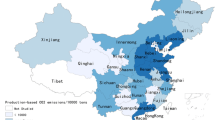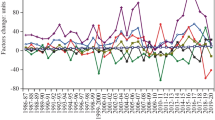Abstract
This study applied the interprovincial input–output model to calculate the carbon footprint of 30 provinces and the interprovincial transfer of embodied CO2 emissions in China. The results indicate that there are significant differences in the carbon footprints and the per capita carbon footprints of these provinces. The provinces with large carbon footprints are the economically developed provinces, while those with high per capita carbon footprints are the provinces that include central cities, such as Beijing and Shanghai, and the areas with abundant resources and heavy industry bases. The spatial transfer of embodied CO2 emissions in China occurs as follows: from economically developed provinces to provinces with rich resources and intensive heavy industries, from southern provinces to northern provinces, and from coastal provinces to inland provinces. To meet the demand of the coastal, southern, and economically developed provinces, the inland, northern provinces have assumed responsibility for most CO2 emissions. Thus, the domain decomposition of the responsibility for the reduction of CO2 emissions in China must take into account the spatial transfer of embodied CO2 emissions. The responsibility of producers and consumers should be integrated when establishing the indexes for the reduction of CO2 emissions in the various provinces of China. To design a comprehensive burden-sharing scheme for CO2 emissions, especially with respect to the carbon tax, the consumer principle needs to be considered; coastal provinces such as Jiangsu, Zhejiang, and Guangdong and southern economically developed provinces are obliged to assume greater responsibility for the reduction of CO2 emissions.








Similar content being viewed by others
Notes
Due to the lack of input–output data for Tibet, the data for Tibet are not included.
We have used the emission coefficient from Liu et al. (Nature 524, 335–338) to calculate the carbon footprint of 30 provinces and the interprovincial transfer of embodied CO2 emissions in China also. We did not find the significant differences in the conclusions of the study, because emission reduction responsibilities are allocated to the various provinces/regions by National Development and Reform Commission in China. We used carbon emission coefficient of the Guidelines for the Compilation of Provincial Greenhouse Gas Inventories (GB/T 2589–2008) published by National Development and Reform Commission of China in this paper.
References
Ahmad N, Wyckoff AW (2009) Carbon dioxide emissions embodied in international trade of goods. http://www.oecd.org/sti/working-papers
Almeida J, Verbist B, Wouter MJ, Achten W et al (2014) Sustainability in development cooperation: preliminary findings on the carbon footprint of development aid organizations. Sustain Dev 22(5):349–359
Baldo GI, Marino M, Montani M et al (2009) The carbon footprint measurement toolkit for the EU econlabel. Int J Life Cycle Assess 14(7):591–596
Bin S, Ang BW (2014) Input–output analysis of CO2 emissions embodied in trade: a multi-region model for China. Appl Energy 114(2014):377–384
Cao S, Xie G (2010) Tracking analysis of carbon footprint flow of China’s industrial sectors. Resour Sci 32(7):2046–2052 (in Chinese)
Chen H (2009) Analysis on embodied CO2 emissions including industrial process emissions. China Popul Resour Environ 19(3):25–30 (in Chinese)
Druckman A, Jackson T (2009) The carbon footprint of UK households 1990–2004: a socio-economically disaggregated, quasi-multi-regional input–output model. Ecol Econ 68(7):1–19
East AJ (2008) Vegetable industry carbon footprint scoping study discussion paper 1: what is a carbon footprint? An overview of definitions and methodologies. Horticulture Australia Limited, Sydney
Edwards JG, Plassmann K, York EH et al (2009) Vulnerability of exporting nations to the development of a carbon label in the United Kingdom. Environ Sci Policy 12:479–490
Ellis G (2007) Meeting the carbon challenge: the role of commercial real estate owners, users & managers. Grubb & Ellis Company, Chicago
Energy Statistics Division of the National Bureau of Statistics of the People’s Republic of China (2009) China energy statistical yearbook. China Statistics Press, Beijing (in Chinese)
Ferng JJ (2003) Allocating the responsibility of CO2 over-emissions from the perspectives of benefit principle and ecological deficit. Ecol Econ 46(1):121–141
Généreux PA, Langen B (2002) The derivation of provincial (inter-regional) trade flows: the Canadian experience, paper prepared for presentation at the 14th international input–output techniques conference, held October 10–15, at the Université du Québec à Montréal, Montréal, Canada
Hammond G (2007) Time to give due weight to the carbon footprint issue. Nature 445(7125):256
Hertwich EG, Peters GP (2009) Carbon footprint of nations: a global trade-linked analysis. Environ Sci Technol 43(16):6414–6420
Li S (2015) China’s Regional Expansion input–output Tables in 2007–Development and Application. Tsinghua University Press, Beijing (in Chinese)
Liang QM, Fan Y, Wei YM (2007) Multi-regional input–output model for regional energy requirements and CO2 emissions in China. Energy Policy. 35(3):1685–1700
Liu Y, Ge Q (2008) Countermeasures against international pressure of reducing CO2 emissions and analysis on China’s potential of CO2 emission reduction. Acta Geographica Sinica. 63(6):675–682
Machado G, Schaeffer R (2001) Energy and carbon embodied in the international trade of Brazil. Ecol Econ 39(3):409–424
MacMinn CW, Juanes R (2009) A mathematical model of the footprint of the CO2 plume during and after injection in deep saline aquifer systems. Energy Procedia. 1(1):3429–3436
Matthews HS, Hendrickson CT, Weber CL (2008) The importance of carbon footprint estimation boundaries. Environ Sci Technol 42(16):5839–5842
Meng B, Xue J, Feng K (2013) China’s inter-regional spillover of carbon emissions and domestic supply chains. Energy Policy. 61(2013):1305–1321
Meng B, Peters GP, Wang Z (2015) Tracing greenhouse gas emissions in global value chains, Stanford Center for international development Wording Paper No. 525
National Bureau of Statistics of the People’s Republic of China (2010) China economic census yearbook. China Statistics Press, Beijing (in Chinese)
Padgett JP, Steinemann AC, Clarke JH (2008) A comparison of carbon calculators. Environ Impact Assess Rev 28(2–3):106–115
Peters GP (2008) From production-based to consumption-based national emission inventories. Ecol Econ 65(1):3–23
POST (2011) Carbon footprint of electricity generation. Parliamentary Office of Science and Technology. POSTnote, 268
Quéré CL, Moriarty R, Andrew RM et al (2015) Global carbon budget 2014. http://www.earth-syst-sci-data.net/7/47/2015/
Rawski TG (2001) What is happening to China’s GDP statistics? China Econ Rev 12(1):671–687
Rees W, Wackernagel M (1996) Our ecological footprint: reducing human impact on the earth. New Society Publishers, Gabriola Island
Sánchez-Chóliz Julio, Duarte Rosa (2004) CO2 emissions embodied in international trade: evidence for Spain. Energy Policy 32(18):1999–2005
Schaeffer R, de Sá A (1996) The embodiment of carbon associated with Brazilian imports and exports. Energy Convers Manag 37(6–8):955–960
Shui B, Harriss RC (2006) The role of CO2 embodiment in US-China trade. Energy Policy. 34(18):4063–4068
Tian X, Chang M, Lin C, Tanikawa H (2014) China’s carbon footprint: a regional perspective on the effect of transitions in consumption and production patterns. Appl Energy 123(15):19–28
Weidema BP, Thrane M, Christensen P et al (2008) Carbon footprint A catalyst for life cycle assessment? J Ind Ecol 12(1):3–6
Wiedmann T (2009) A review of recent multi-region models used for consumption-based emission and resource accounting. Ecol Econ 69(2):211–222
Wiedmann T, Minx J (2007) A definition of carbon footprint. ISA research report, pp 1–7. www.earth-syst-sci-data.net/7/47/2015/
Wyckoff AW, Roop JM (1994) The embodiment of carbon in imports of manufactured products: implications for international agreements on greenhouse gas emissions. Energy Policy 22(3):187–194
Zhang S, Li S (2013) Evolution trend, characteristics and outlook of the inter-provincial trade in China: from 1987 to 2007. Finance Econ 10(5):100–107 (in Chinese)
Zhao R (2010) Research on carbon emission intensity and carbon footprint of different industrial spaces in China. Acta Geographica Sinica. 65(10):1048–1057 (in Chinese)
Author information
Authors and Affiliations
Corresponding author
Appendix
Appendix
See Table 4.
Rights and permissions
About this article
Cite this article
Wu, S., Lei, Y. & Li, S. Provincial carbon footprints and interprovincial transfer of embodied CO2 emissions in China. Nat Hazards 85, 537–558 (2017). https://doi.org/10.1007/s11069-016-2585-5
Received:
Accepted:
Published:
Issue Date:
DOI: https://doi.org/10.1007/s11069-016-2585-5




